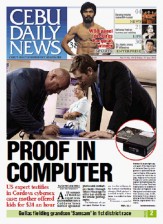US expert testifies in Cordova cybersex case; mother offered kids for $24 an hour

The testimony of special agent Matthew Swenson was key evidence in the human trafficking charges filed against a married couple, whose house was raided in June last year.
Swenson, a special agent of the United State Department of Homeland Security, presented two hard discs taken from the home computer of the Cordova couple.
The contents – photos and chat messages – were recovered from the computer and analyzed.
Swenson showed that the mother kept three different YM accounts under different user names for chat messages to transact cyber sex business with a client abroad.
In the chat messages, the mother would offer to do a show with the children for $25 to $35 per hour.
Article continues after this advertisementThese were some of the findings presented to Judge Silvestre Maamo of the Regional Trial Court (RTC) Branch 55 in Mandaue City.
Article continues after this advertisementSwenson is the last witness to be presented by the prosecution in the case of qualified trafficking by a couple who engaged five of their children and their young niece in a home-based cybersex operation.
The couple, dressed in orange prison shirts, sat on a bench in front.
Throughout the hearing, their eyes seldom left the projector screen where sample photos were flashed.
At times, the woman was teary-eyed and would wipe her eyes with a towel. Her husband would stare at the floor and sometimes crumple the baseball cap in his hands.
When the chat messages were flashed on screen, the father shook his head, closed his eyes for a second and let out a deep breath.
Before the hearing, CEBU DAILY NEWS tried to ask the couple about their present condition.
Asked about the whereabouts of their youngest child, who was born in November last year when the mother was in prison, the woman burst into tears. They wouldn’t talk.
The couple’s children were turned over to the Department of Social Welfare and Development, and are staying in a safe house, according to officials.
Based on the chat messages, the couple had been operating the cybersex business for several months, Swenson told the court.
He said the PC was acquired in May 2010 based on the digital information in the hard drive. The chat messages started in December 2010. The last chat message was made on June 2011, the day the house was raided by the National Bureau of Investigation (NBI).
The identity of a male Caucasian in photos with young Filipina girls still has to be established.
“There is no showing that he is an American,” Cebu assistant provincial prosecutor Lolita Lomanta told reporters.
“But if he is, I’m very sure by now that the agents of Homeland Security must have knocked on his door and conducted an investigation.”
Cross examination by the defense is scheduled at 1 p.m. today.
Swenson was the agent who took charge of examining a Samsung hard drive recovered from the couple’s personal computer after NBI operatives raided the small house in Cordova town, Mactan last year.
With a pentel pen and illustration board, he showed how he made a forensic image of the hard drive to analyze, while preserving the original hard drive and installing a blocking device to prevent any alterations of the content.
The original copy is stored in an evidence locker protected by a security system that can only be accessed by four people in their agency.
Swenson, who said he had no access to the locker, assured the court that the evidence in the hard drive was not tampered.
Swenson submitted a 99-page analysis report, where he said the PC’s hard drive had the username of the arrested woman.
She was registered as the owner of the computer and its administrator.
This means the woman had control over deciding who could access the PC, said prosecutor Lomanta.
Swenson said he was able to recover from the hard drive an image of a Caucasian with six teenagers somewhere in a public area.
Another photo showed a screen shot of the same Caucasian having a Yahoo Messenger conversation with a teenage girl.
(The defense panel said they could not establish the girl was one fo the couple’s daughters.)
On page 7 of his report, Swenson stated that he recovered five photos that were deleted and placed in the Recycled Bin.
Using a laptop and LCD projector, the prosecution flashed a photo on screen showing the teenage girl , this time only wearing a white bra. The shot showed her upper body from breast to mouth.
Swenson said the girl has the same profile of that young girl in the previous screen shot.
Using the software program File Juicer he was able to recover 12 other photos.
The first image showed a photo of two adult women and two young girls.
(As the image flashed, the detained mother whispered to her husband that the photo was taken outside the airport arrival area.)
The second image showed the same women but this time in the company of a male Caucasian wearing a yellow shirt, yellow cap and a checkered shorts.
This time Lomanta asked the defense panel if they could establish that the woman wearing a red dress in the photo was the mother accused of cyberpornography.
The defense panel admitted that it was her.
Five other photos showed the Caucasian male with the mother, the two young girls and a third girl believed to be the three-year-old daughter of the couple.
The remaining five photos showed the same young girl with the Caucasian inside a room with similar red and white drapes and a green background.
After these photos were presented, Lomanta compared the photos, matching the Caucasian with the one seen in the Yahoo messenger screen shot in the company of a young girl.
It was the same Caucasian man that appeared in all photos, said Swenson.